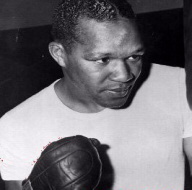 12.12.07 – By Ted Sares: I was nine years old and I vaugely recall something about my dad wanting to take me to the Chicago Coliseum in April 1946 to see a youthful and popular bomber by the name of Bob Satterfield, 12-1 at the time, go up against a veteran middleweight who boxed with the speed and cleverness of a lightweight. It would be the main event in a card that also included Roy Cadie vs. Torpedo Reed and Tony Musto tangling with Dick Ieves.
12.12.07 – By Ted Sares: I was nine years old and I vaugely recall something about my dad wanting to take me to the Chicago Coliseum in April 1946 to see a youthful and popular bomber by the name of Bob Satterfield, 12-1 at the time, go up against a veteran middleweight who boxed with the speed and cleverness of a lightweight. It would be the main event in a card that also included Roy Cadie vs. Torpedo Reed and Tony Musto tangling with Dick Ieves.
In 1945, I had seen Satterfield destroy Art McWhorter in one savage round at the Marigold Gardens. He floored McWhorter three times; first from a left hook, second from a volley of shots, and finally from a left hook that dropped him for the count. It was pure but beautiful violence.
The attraction on this 1946 night would be the youth and explosiveness of “Rapid Robert,” 168½ and 22, vs. the style and experience of Williams, 34, who was 138-22-10 coming in and a 2 to 1 favorite. Most Chicago fans did their betting under the numerous “no betting” signs that were scattered throughout the Coliseum. This was done as a kind of post-war thing that said “we damm well will do anything we want.” That was pure post-war Chicago back in the day and the vets were not to be messed with. They had paid their dues.
The fight drew 6,500 people, the largest crowd since the 30’s, and most were there to see Satterfield unload one of his lethal lefts or crunching rights on a veteran who was considered the quintessential “cutie” and one of the best defensive fighters of the 40s
The winner stood to fight Jake LaMotta making the fight even more intriguing.
In his previous duke, the rangy, slick-boxing Williams lost to none other than the Chocolate Kid, Bert Lytell, but prior to that, he had put together a 14-fight undefeated streak including two wins over the aforementioned Lytell and one over future Hall-of-Fame inductee Charley Burley. Also included in this streak, were wins over The Cocoa Kid (165-44-8 at the time) and the great Archie Moore. In all, he would go 3-8-2 against The Kid, 3-3-1 against rugged Jose Basora, and 3-3-0-1 against Charley Burley, though I have not been able to verify these figures to the level of exactness I prefer. His career began in 1932 and ended in 1948. He came out of the professional gate fast losing only once in his first 32 fights. Included in this fast start was a win in 1935 for the Negro Lightweight Title.
Back to the Coliseum
Unfortunately, I never did get to that 1946 fight. My dad took my brother instead (he had returned from the War in 1945) and their account of it was that Satterfield gave a great showing but simply could not reach Williams who was able to dodge and deflect the bomber’s shots, though it would later be said that even when Bob missed, he could hurt you. As it were, Williams won an entertaining ten round decision with young Bob stalking throughout but never catching the veteran. Little did I know that some 62 years later, Williams would be inducted into the International Boxing Hall of Fame.
Holman would then fight and lose to future Hall of Famers Marcel Cerdan and LaMotta in succession. But these two losses came after he had been a professional fighter for many years and time had caught up to him. He would lose 11 of his remaining 22 fights, as his magnificent reflexes waned. Still, he fought top notch opposition right up to the end in 1948, and some of those defeats were controversial as well. His final record was an amazing 146-30-11. And get this; he was stopped only three times–once on cuts! He fought many times in New Orleans and Chicago, but he was the essence of a road warrior and toiled at his trade in just about every big city in the country.
The legendary trainer, Eddie Futch, has often cited Holman Williams and Charley Burley as the two greatest fighters he ever had the privilege to see and was quoted as saying that he would rather watch Williams shadow box than watch most other fighters in action. (Harry Otty, “Why Holman Williams Belong in the Hall-of-Fame.” Wail The CBZ JOURNAL, July 2006)
Avoided by many of the higher ranked white fighters (and historically neglected by all except aficionados), this great technical boxing wizard fought the best welterweights, middleweights and light-heavyweights of his time. Inducting him into the International Boxing Hall of Fame in 2008, albeit posthumously, is manifestly the right thing to do.
Tragically, he died in a fire in Akron, Ohio in 1967 at age 52.
Holman Williams was a great boxer, but he never got the recognition because he wasn’t a puncher. He had the finesse of a Ray Robinson, but no punch.” –Eddie Futch